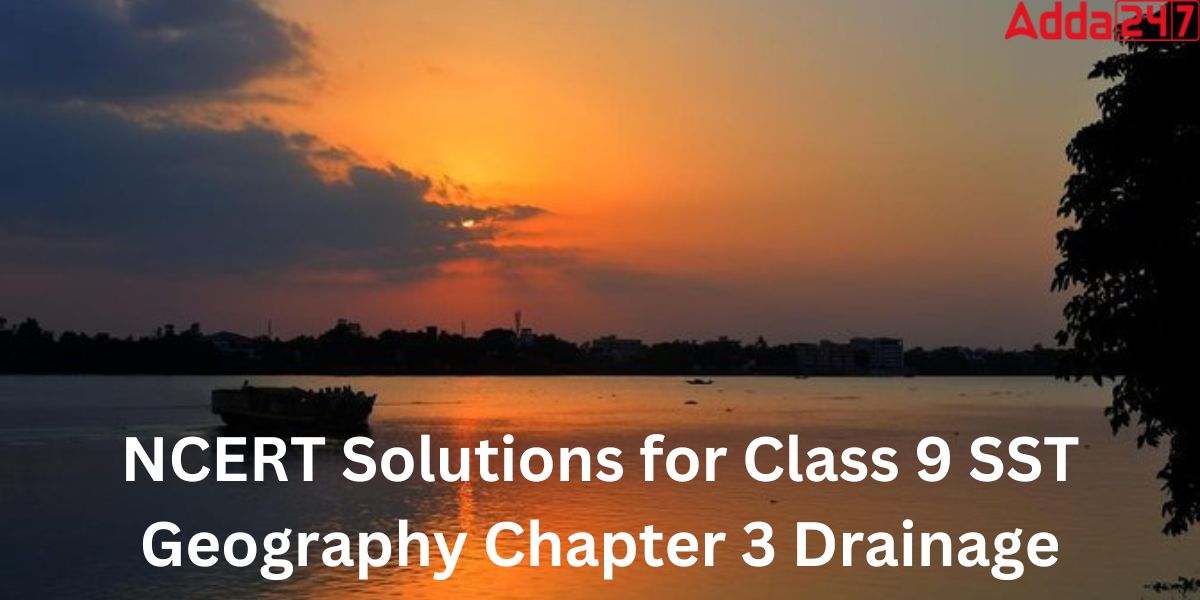NCERT Solutions Class 9 SST Geography Chapter 3 Drainage Notes
NCERT Solutions for Class 9 SST Geography Chapter 3 Drainage notes are provided in this article. NCERT Solutions for class 9 is the finest resource for getting a high score on the class 9 Examination. Adda247 Expert faculty team prepared NCERT Solutions for Class 9 SST Geography Chapter 3 Drainage exercises of that chapter for a better grasp of the topics. These NCERT Solutions answer all questions in an easy and simple manner. These solutions will help you understand the concepts covered in the chapter completely. By writing these answers in the exam students will undoubtedly be able to achieve high scores. Keep learning with Adda247.
NCERT Solutions for Class 9 SST Geography Chapter 3 Drainage Pdf
NCERT Solutions for Class 9 SST Geography Chapter 3 Drainage pdf is given in pdf format so students can easily download it for future use. Click here to download NCERT Solutions for Class 9 SST Geography Chapter 3 Drainage
Class 9 SST Geography Chapter 3 Drainage Ncert Solutions Video Explanation
Class 9 SST Geography Chapter 3 Drainage Summary
Class 9 SST Geography Chapter 3 Drainage introduces to students about the drainage system of India. This chapter talks about various rivers such as the Himalayan Rivers, Peninsular Rivers, and lakes in India. Before going to NCERT Solutions for Class 9 SST Geography Chapter 3 Drainage, Let’s take a tour of the topics which are included in this chapter:
1. The Himalayan Rivers
- The Indus River System
- The Ganga River System
- The Brahmaputra River System
2. The Peninsular Rivers
- Narmada Basin
- Tapi Basin
- Godavari Basin
- Mahanadi Basin
- Krishna Basin
- Kaveri Basin
3. Lakes
4. Role of Rivers in Economy
NCERT Solutions for Class 9 SST Geography Chapter 3 Drainage Questions with Answer
1. Choose the right answer from the four alternatives given below.
(i) In which of the following states is the Wular lake located?
(a) Rajasthan (b) Punjab (c) Uttar Pradesh (d) Jammu and Kashmir
Answer:(d)Jammu and Kashmir.
(ii) The river Narmada has its source at
(a) Satpura (b) Amarkantak (c) Brahmagiri (d) Slopes of the Western Ghat.
Answer: (b)Amarkantak
(iii) Which one of the following lakes is a saltwater lake?
(a) Sambhar (b) Wular (c) Dal (d) Gobind Sagar
Answer: (a)Sambhar
(iv) Which one of the following is the longest river in Peninsular India?
(a) Narmada (b) Godavari (c) Krishna (d) Mahanadi
Answer: (b)Godavari
(v) Which one amongst the following rivers flows through a rift valley?
(a) Mahanadi (b) Krishna (c) Tungabhadra (d) Tapi
Answer: (d) Tapi
2. Answer the following questions briefly.
(i) What is meant by a water divide? Give an example.
Answer: Any elevated land, such as a mountain or upland, divides two drainage basins. Such an upland is referred to as a water divide. For example, Western Ghats.Eastern Ghats
ii) Which is the largest river basin in India?
Answer: The Ganga River basin is the largest river basin in India.
(iii) Where do the rivers Indus and Ganga have their origin?
Answer: The Ganga River originates in the Gangotri Glacier in the state of Uttarakhand, whereas the Indus River has its source in Tibet close to Mansarovar Lake.
(iv) Name the two headstreams of the Ganga. Where do they meet to form the Ganga?
Answer: The two headstreams of the Ganga are the Alaknanda and the Bhagirathi. At Devprayag, they both merge to form the Ganga.
(v) Why does the Brahmaputra in its Tibetan part have less silt, despite a longer course?
Answer: The Brahmaputra River in Tibet barely receives a small quantity of water and silt. But after entering India from Arunachal Pradesh, it passes through an area with heavy rainfall, carrying a lot of water and silt with it.
(vi) Which two Peninsular rivers flow through a trough?
Answer: Narmada and Tapi are the two Peninsular rivers that flow through a trough.
(vii) State some economic benefits of rivers and lakes.
Answer: The importance of rivers and lakes to humans is significant. Rivers are the sources of freshwater that are necessary for all living things to survive and are used for irrigation, drinking, and industrial purposes. Water bodies are used for navigation and transportation. Lakes and rivers are extremely important to agriculture.
3. Below are given names of a few lakes in India. Group them under two categories – natural and created by human beings. (a) Wular (b) Dal (c) Nainital (d) Bhimtal (e) Gobind Sagar (f) Loktak (g) Barapani (h) Chilika (i) Sambhar (j) Rana Pratap Sagar (k) Nizam Sagar (l) Pulicat (m) Nagarjuna Sagar (n) Hirakund
Answer:
| Natural Lakes | Man Made Lakes |
| – Barapani – Dal – Bhimtal – Chilika – Loktal – Nainital – Sambhar – Pulicat – Wular |
– Hirakud – Gobind Sagar – Nizam Sagar – Nagarjuan Sagar – Rana Pratap Sagar |
4. Discuss the significant difference between the Himalayan and the Peninsular rivers.
Answer:
| Himalayan River | Peninsular River |
| Himalayan rivers are perennial. | Peninsular rivers are seasonal, |
| The waterways that flow from the Himalayan mountain ranges’ northernmost points are known as Himalayan Rivers. | Waterways that originate in the Western Ghats or Central Highlands are referred to as peninsular rivers. |
| Himalayan rivers obtain water from snow and rain, | Peninsular rivers only receive water from rain. |
| They have big drainage basins. | They have small drainage basins. |
| The sedimentary, brittle, and easily erodible bedrock of the Himalayan rivers. | Peninsular rivers’ bedrock is solid, resistant, and difficult to erode. |
5. Compare the east-flowing and the west-flowing rivers of the Peninsular plateau.
Answer:
| East-Flowing Rivers | West-Flowing Rivers |
| The Western Ghats are the source of East-Flowing Rivers | West Flowing rivers move westward from their source in central India. |
| East Flowing rivers have bigger sediments than rivers that flow west | West Flowing River transport fewer sediments |
| These rivers originate at deltas. | These rivers create estuaries. |
| They can transport more water. | They transport less water. |
| The Bay of Bengal is the end of west-flowing rivers. | West Flowing rivers empty into the Arabian Sea. |
6. Why are rivers important for the country’s economy?
Answer: Rivers are a precious natural resource and have a significant economic impact on a country. Throughout human history, rivers have been of vital importance. By transporting mineral-rich silt, they also ensure soil fertility while delivering water for irrigation operations. They also act as a possible source of hydroelectric electricity. It is crucial for economic activity and is also used for transportation and navigation. Since ancient times, settlers have been drawn to riverbanks. These towns have since developed into large cities
NCERT Solutions for Class 9 SST Geography Chapter 3 Drainage: Video Solution
NCERT Solutions for Class 9 SST Geography Chapter 3 Drainage-FAQs
Q. What is drainage Ncert Class 9?
The term “drainage” refers to the network of rivers in a certain area. It is a mechanism that directs water from one level to another. An area that is drained by a single river system is known as a drainage basin or river basin. An upland that divides two irrigation systems that are close to one another is referred to as a water division.
Q. How can I access the online PDF version of the NCERT Solutions for Class 9 SST Geography Chapter 3 Drainage?
Ans. The NCERT Solutions for Class 9 SST Geography Chapter 3 Drainage PDF may be downloaded using the link in the article.
Q. What are the advantages of using Adda247’s NCERT Solutions for Class 9 SST Geography Chapter 3 Drainage?
Ans. The advantages of using NCERT Solutions for Class 9 SST Geography Chapter 3 Drainage from Adda247 include the following:
- The NCERT solution as well as a video explanation
- Additionally, a PDF is included, which can be downloaded and saved for future use









 CBSE 2026 Preparation Tips for Class 12
CBSE 2026 Preparation Tips for Class 12
 CUET Syllabus 2026: Download Subject-Wis...
CUET Syllabus 2026: Download Subject-Wis...
 CUET Commerce Syllabus 2026, Download Su...
CUET Commerce Syllabus 2026, Download Su...














